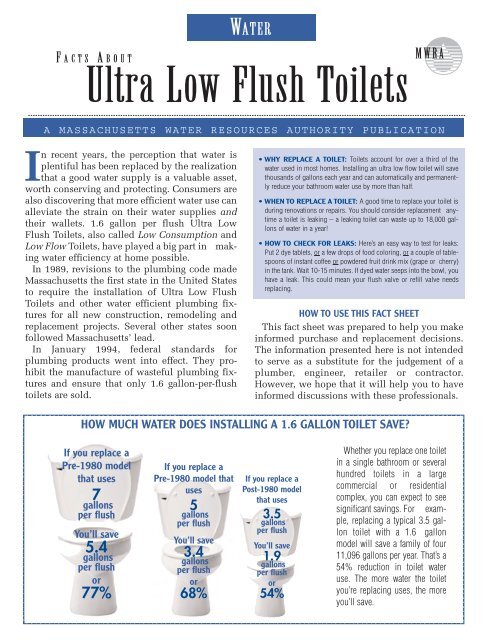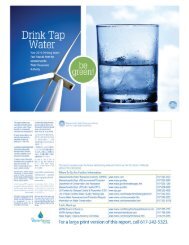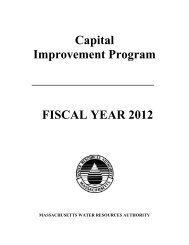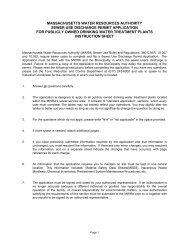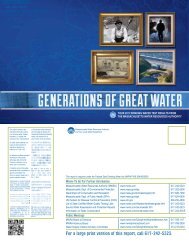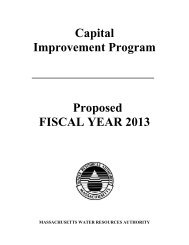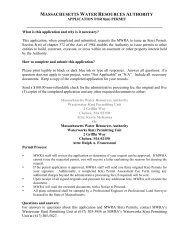Ultra Low Flush Toilets - Massachusetts Water Resources Authority
Ultra Low Flush Toilets - Massachusetts Water Resources Authority
Ultra Low Flush Toilets - Massachusetts Water Resources Authority
Create successful ePaper yourself
Turn your PDF publications into a flip-book with our unique Google optimized e-Paper software.
WATER<br />
F ACTS A BOUT<br />
<strong>Ultra</strong> <strong>Low</strong> <strong>Flush</strong> <strong>Toilets</strong><br />
MWRA<br />
A<br />
MASSACHUSETTS WATER RESOURCES AUTHORITY PUBLICATION<br />
In recent years, the perception that water is<br />
plentiful has been replaced by the realization<br />
that a good water supply is a valuable asset,<br />
worth conserving and protecting. Consumers are<br />
also discovering that more efficient water use can<br />
alleviate the strain on their water supplies and<br />
their wallets. 1.6 gallon per flush <strong>Ultra</strong> <strong>Low</strong><br />
<strong>Flush</strong> <strong>Toilets</strong>, also called <strong>Low</strong> Consumption and<br />
<strong>Low</strong> Flow <strong>Toilets</strong>, have played a big part in making<br />
water efficiency at home possible.<br />
In 1989, revisions to the plumbing code made<br />
<strong>Massachusetts</strong> the first state in the United States<br />
to require the installation of <strong>Ultra</strong> <strong>Low</strong> <strong>Flush</strong><br />
<strong>Toilets</strong> and other water efficient plumbing fixtures<br />
for all new construction, remodeling and<br />
replacement projects. Several other states soon<br />
followed <strong>Massachusetts</strong>’ lead.<br />
In January 1994, federal standards for<br />
plumbing products went into effect. They prohibit<br />
the manufacture of wasteful plumbing fixtures<br />
and ensure that only 1.6 gallon-per-flush<br />
toilets are sold.<br />
• WHY REPLACE A TOILET: <strong>Toilets</strong> account for over a third of the<br />
water used in most homes. Installing an ultra low flow toilet will save<br />
thousands of gallons each year and can automatically and permanently<br />
reduce your bathroom water use by more than half.<br />
• WHEN TO REPLACE A TOILET: A good time to replace your toilet is<br />
during renovations or repairs. You should consider replacement anytime<br />
a toilet is leaking – a leaking toilet can waste up to 18,000 gallons<br />
of water in a year!<br />
• HOW TO CHECK FOR LEAKS: Here’s an easy way to test for leaks:<br />
Put 2 dye tablets, or a few drops of food coloring, or a couple of tablespoons<br />
of instant coffee or powdered fruit drink mix (grape or cherry)<br />
in the tank. Wait 10-15 minutes. If dyed water seeps into the bowl, you<br />
have a leak. This could mean your flush valve or refill valve needs<br />
replacing.<br />
HOW TO USE THIS FACT SHEET<br />
This fact sheet was prepared to help you make<br />
informed purchase and replacement decisions.<br />
The information presented here is not intended<br />
to serve as a substitute for the judgement of a<br />
plumber, engineer, retailer or contractor.<br />
However, we hope that it will help you to have<br />
informed discussions with these professionals.<br />
HOW MUCH WATER DOES INSTALLING A 1.6 GALLON TOILET SAVE<br />
If you replace a<br />
Pre-1980 model<br />
that uses<br />
7<br />
gallons<br />
per flush<br />
You’ll save<br />
5.4<br />
gallons<br />
per flush<br />
or<br />
77%<br />
If you replace a<br />
Pre-1980 model that<br />
uses<br />
5<br />
gallons<br />
per flush<br />
You’ll save<br />
3.4<br />
gallons<br />
per flush<br />
or<br />
68%<br />
If you replace a<br />
Post-1980 model<br />
that uses<br />
3.5<br />
gallons<br />
per flush<br />
You’ll save<br />
1.9<br />
gallons<br />
per flush<br />
or<br />
54%<br />
Whether you replace one toilet<br />
in a single bathroom or several<br />
hundred toilets in a large<br />
commercial or residential<br />
complex, you can expect to see<br />
significant savings. For example,<br />
replacing a typical 3.5 gallon<br />
toilet with a 1.6 gallon<br />
model will save a family of four<br />
11,096 gallons per year. That’s a<br />
54% reduction in toilet water<br />
use. The more water the toilet<br />
you’re replacing uses, the more<br />
you’ll save.
WATER<br />
HOW MUCH MONEY CAN YOU SAVE<br />
<strong>Water</strong> savings can be converted into dollar savings. The charts on this fact sheet present<br />
examples of the amount of money an average family of four can save, and the calculation for<br />
determining the ‘payback’ from your investment.<br />
YEARLY SAVINGS FOR A FAMILY OF FOUR<br />
FROM SWITCHING TO AN ULTRA LOW FLUSH TOILET<br />
Gallons<br />
per flush<br />
X<br />
Daily<br />
<strong>Flush</strong>es<br />
X<br />
People in<br />
household<br />
Days in<br />
X X<br />
a year<br />
Average cost of<br />
1,000 gallons<br />
water and sewer<br />
÷<br />
1,000<br />
gallons<br />
=<br />
Cost<br />
per year<br />
3.5 gallon<br />
(old model)*<br />
X<br />
4 X 4 X 365 X $7.00 ÷ 1,000 = $143.00<br />
1.6 gallon<br />
(<strong>Ultra</strong> <strong>Low</strong><br />
<strong>Flush</strong> Model)<br />
X<br />
4 X 4 X 365 X $7.00 1,000 $65.00<br />
÷ =<br />
*without a toilet dam<br />
Yearly Savings with<br />
the <strong>Ultra</strong> <strong>Low</strong> <strong>Flush</strong> Toilet:<br />
=<br />
$ 78.00<br />
CALCULATE YOUR PAYBACK TIME<br />
Your payback time is the time it will take for you to recover the cost of buying and<br />
installing an ultra low flush toilet.<br />
Your payback time will depend on the amount of water your old toilet uses and the cost to<br />
purchase and install a 1.6 gallon model.<br />
SAMPLE PAYBACK TIME FOR SWITCHING<br />
TO AN ULTRA LOW FLUSH TOILET<br />
Approximate<br />
Installation<br />
Cost<br />
÷ Yearly<br />
Savings = Payback<br />
Time<br />
$260.00 ÷ $78.00 = 3.3 years<br />
Installation cost includes labor and materials for replacing a 3.5 gallon toilet with a typical 1.6 gallon model in white.
WATER<br />
HOW TO CHOOSE A TOILET<br />
Not all <strong>Ultra</strong> <strong>Low</strong> <strong>Flush</strong> <strong>Toilets</strong> are the same. Customer satisfaction varies among different types,<br />
models and manufacturers. There is also a wide range in price. Before you buy, consider which type<br />
of toilet is best for your home or building. These checklists can guide you in your search.<br />
WHICH TYPE OF TOILET<br />
IS RIGHT FOR YOU<br />
Consider which of the residential<br />
ultra low flush toilet types is best<br />
for your home:<br />
• GRAVITY TOILETS are the most common.<br />
<strong>Water</strong> is stored in a tank and<br />
when flushed, the water is<br />
released through a flapper valve<br />
and driven by gravity to clear out<br />
the bowl. These toilets require<br />
approximately 10-15 pounds per<br />
square inch (psi) of pressure at the<br />
connection to function properly.<br />
Gravity toilets are relatively inexpensive,<br />
ranging from $75 to<br />
$150.<br />
• PRESSURE ASSISTED TOILETS are<br />
hybrids of gravity and flush valve<br />
toilets. A pressurized tank placed<br />
inside the porcelain tank compresses<br />
a pocket of air and releases<br />
pressurized water into the bowl<br />
and out the trapway at high velocity.<br />
The flushing action of these<br />
toilets is noisier than the gravity<br />
types’, and they require a minimum<br />
water pressure of 25 psi to<br />
operate properly. Prices for these<br />
toilets are usually over $150.<br />
• FLUSHOMETER TOILETS are found in<br />
most commercial buildings. They<br />
have no tank but rely instead on a<br />
pressure-operated valve directly<br />
connected to the building’s water<br />
supply. They require a large supply<br />
pipe and a minimum water<br />
pressure of 23-40 psi to operate<br />
well. These toilets are priced at<br />
about $250.<br />
PERFORMANCE<br />
Customer satisfaction surveys<br />
show that newer 1.6 gallon<br />
toilets perform as well, if<br />
not better than, the 3.5 gallon<br />
water-wasters they replace.<br />
Customer concerns about<br />
clogging and double-flushing<br />
of earlier <strong>Ultra</strong> <strong>Low</strong> <strong>Flush</strong><br />
models have been addressed<br />
by manufacturers, and<br />
today’s toilets have been<br />
redesigned to improve performance.<br />
Several design and<br />
plumbing features factor into<br />
how well an <strong>Ultra</strong> <strong>Low</strong> <strong>Flush</strong><br />
Toilet works:<br />
• WATER SEAL: The surface<br />
area of the water standing in<br />
the bowl, which correlates<br />
with bowl staining. A small<br />
water seal can produce<br />
more staining and require<br />
more frequent cleanings.<br />
• WASTE REMOVAL: How well<br />
the toilet evacuates bulk<br />
and waste from the bowl.<br />
Insufficient waste removal<br />
is the main cause of doubleflushing.<br />
• DILUTION: The completeness<br />
of water change in the bowl.<br />
• DRAIN LINE CARRY: How far<br />
the toilet transports solid<br />
waste down a sewer line.<br />
• NOISE: What you hear when<br />
you flush.<br />
FACTORS THAT AFFECT COST<br />
• COLOR: ‘Natural’ and other nonewhite<br />
finishes may cost more.<br />
• BOWL SHAPE: Elongated or round<br />
bowls can differ in price.<br />
• DESIGN: One-piece or two-piece<br />
models are available. One-piece<br />
models are usually more expensive.<br />
• ROUGH IN: The distance from the<br />
wall to the flange bolts that hold<br />
the toilet down. Standard is 12<br />
inches, but 10-inch and 14-inch<br />
models are also available. Make<br />
sure you buy the right size.<br />
YOU SHOULD ALSO CONSIDER...<br />
• GLAZED TRAPWAYS: Most models<br />
have this feature, which<br />
improves waste removal and<br />
reduces staining.<br />
• NOISE LEVELS: Pressure-assisted<br />
toilets tend to be louder than<br />
gravity models. Ask about toilet<br />
noise levels before you buy.<br />
• THE FOOTPRINT: Check the footprint<br />
of your new toilet to determine<br />
if any floor patching will<br />
need to be done around the base.<br />
• WARRANTIES: Look for manufacturer<br />
warranties that guarantee<br />
the toilet components for many<br />
years.<br />
• EXPERTISE: We recommend that<br />
you consult a licensed plumber<br />
before installing any toilet.
WATER<br />
FIND YOUR YEARLY DOLLAR SAVINGS FROM INSTALLING AN ULTRA LOW FLUSH TOILET*<br />
Use the number in the left hand column that’s closest to your home’s average number of flushes per day and the dollar<br />
amount that’s closest to your community’s water rate to find your yearly dollar savings. Check with your local<br />
water/sewer utility, or visit MWRA’s website: WWW.MWRA.STATE.MA.US/ORG/HTML/RATES_HOUSE_CHARGES.HTM for your current rate.<br />
CITY/TOWN COMBINED WATER AND SEWER RATES IN COST PER 100 CUBIC FEET**<br />
$4 $5 $6 $7 $8 $9 $10 $11<br />
AVERAGE YEARLY SAVINGS<br />
$8 $ 11 $ 51 $ 14 $ 17 $ 19 $ 21 $ 23<br />
$13 $ 16 $ 19 $ 22 $ 25 $ 28 $ 32 $ 35<br />
$17 $ 21 $ 25 $ 30 $ 33 $ 38 $ 41 $ 46<br />
$21 $ 26 $ 32 $ 37 $ 41 $ 47 $ 52 $ 56<br />
$25 $ 32 $ 38 $ 44 $ 50 $ 56 $ 62 $ 69<br />
$29 $ 37 $ 44 $ 51 $ 59 $ 65 $ 73 $ 80<br />
$33 $ 41 $ 50 $ 59 $ 67 $ 75 $ 83 $ 92<br />
$38 $ 47 $ 56 $ 65 $ 75 $ 84 $ 94 $ 103<br />
$41 $ 52 $ 63 $ 73 $ 83 $ 94 $ 104 $ 115<br />
* Assumes that one 3.5 gallon per flush toilet, in a model installed after 1980, is being replaced. Earlier models may use up to 7.0 gallons per flush, in which case your savings<br />
would be even greater.<br />
** 100 cubic feet = 750 gallons<br />
A WORD ABOUT FLAPPERS<br />
<strong>Water</strong> savings from an <strong>Ultra</strong> <strong>Low</strong> <strong>Flush</strong> Toilet can be significantly<br />
reduced if the flush valve closure device called a flapper<br />
doesn’t work properly. Flappers have an average life span of<br />
five years before they begin to fail, creating water leaks.<br />
Replacing a worn out flapper with one that is compatible is<br />
essential for maintaining your <strong>Ultra</strong> <strong>Low</strong> <strong>Flush</strong> Toilet’s water<br />
savings. Replacement flappers for some <strong>Ultra</strong> <strong>Low</strong> <strong>Flush</strong> <strong>Toilets</strong><br />
can be hard to find. Try contacting the toilet’s manufacturer, or<br />
call MWRA at 617-242-7283 (SAVE) for suggestions.<br />
REFERENCES AND PERFORMANCE TESTS<br />
The American National Standards Institute (ANSI) designs<br />
minimum performance tests and standards for <strong>Ultra</strong> <strong>Low</strong> <strong>Flush</strong><br />
<strong>Toilets</strong>. Make sure you choose a model that meets these standards.<br />
Several excellent studies have been conducted. Here is a<br />
list of resources for more information.<br />
• THE WATER EFFICIENCY CLEARINGHOUSE (WATER WISER): 6666 West Quincy<br />
Avenue, Denver, CO 80235-9913. Tel:1-(800) 559-9855, website: WWW.WATERWISER.ORG. See<br />
“<strong>Water</strong> Conservation Tips for the Home” under the books heading.<br />
• CONSUMER REPORTS: “<strong>Low</strong> <strong>Flush</strong> <strong>Toilets</strong>, In search of a Better Toilet”. Vol. 63, No. 5,<br />
pages 44-46, May 1998.<br />
• SEATTLE PUBLIC UTILITIES: Owner’s guide on Purchasing <strong>Low</strong> Consumption <strong>Toilets</strong>:<br />
WWW.CITYOFSEATTLE.NET/UTIL/EFFICIENTTOILETS<br />
• TERRY LOVE’S CONSUMER TOILET REPORTS: A Plumber’s Report on <strong>Low</strong> Flow <strong>Water</strong><br />
Efficient <strong>Toilets</strong>: WWW.TERRYLOVE.COM/CRTOILET.COM<br />
• RELATED WEBSITE:<br />
WWW.TOILETOLOGY.COM<br />
rev. 11/2006<br />
REMEMBER...<br />
• NEVER use your toilet as a waste<br />
basket. Synthetic fibers such as dental<br />
floss or plastic wrappers can clog<br />
drains and cause backups.<br />
• ALWAYS hold down the handle until<br />
the tank fully empties (some<br />
models don’t have a quick flush).<br />
• NEVER use toilet bowl cleaners<br />
inside the tank. They’re corrosive,<br />
causing parts to disintegrate,<br />
resulting in leaks.<br />
MWRA offers a variety of informational materials<br />
on the region’s water and wastewater systems<br />
and the natural environment. To find out<br />
what’s available:<br />
CALL US:<br />
MWRA Public Info Line: 617-788-1170<br />
MWRA <strong>Water</strong> Conservation Line: 617-242-7283 (SAVE)<br />
VISIT OUR WEB SITE: WWW.MWRA.COM<br />
WRITE TO US:<br />
MWRA<br />
Public Information Unit<br />
Charlestown Navy Yard<br />
100 First Avenue<br />
Boston, MA 02129<br />
MWRA


